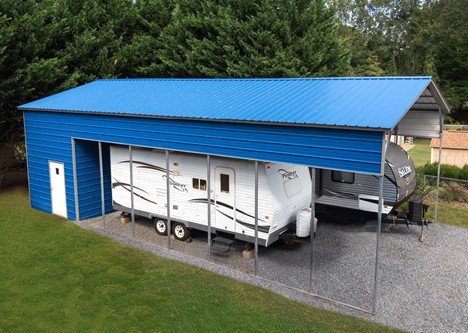Buying an RV is an investment, and once you made that investment, you want to ensure that your vehicle is protected from the elements. If you live in an area prone to harsh weather conditions, such as snow, heavy rain, high winds, or intense sun, you certainly should consider a carport to protect your RV. But even normal weather can have an impact on a vehicle left in the open. The flat roof design of your RV means moisture from snow and rain can stand for days, working its way into seams and damaging flashing. Sun also damages caulked joints, making them more susceptible to leakage.
Your best choice then for those months when you are not traveling is to build a carport where you can store your vehicle. While you can build carports out of wood, they are more time consuming to construct, often more expensive, and are not as easily customizable. You can purchase tent-like structures for less, but they are subject to damage from weather and don’t offer the same level of protection. A good choice is to consult a professional who can offer you metal construction that can either be purchased prefab or as customizable units. Metal offers incredible strength for the price and lasts against the worst weather. And because they are customizable, you can match your carport to the size of your vehicle and the environmental needs for the area in which you live.
Here’s what you need to know before you purchase a carport for your RV:
- Measure: You’ll need to consider the height, length, and width of your vehicle. For height, consider the sidewall height of the carport as well as the height of the peak. While the center may be high enough, a roof that slopes down to walls that are too low means you won’t be able to fit. For the width, you’ll want to allow room for both doors to stand open, and, if you have a slide out, you’ll want to consider whether you want to be able to open it for cleaning or maintenance in the carport space. Length depends upon whether you want extra space to work or to store other items. Most standard carports start at 21 feet long and increase in increments of 5 feet. The standard width is 12 feet. The average height of Class A and C motor homes is about 10 feet, while Class Bs average 7-9 feet.
- Find a large flat spot: You will want plenty of level ground and you’ll want to place the carport away from wooded areas or large trees that can cause damage.
- Check local ordinances: You may need to file paperwork, obtain licenses and permissions, and ascertain that local homeowners association regulations allow for such structures.
- Consider ground cover: You can certainly pave the area from the road to your shed, but it isn’t absolutely necessary. Should you choose not to, consider whether you need additional ground cover to allow you to drive in harsh weather. Gravel is a good choice for the budget conscious.
- Check insurance: review your home owner’s insurance policy to see if the structure will be covered. You may need to purchase an additional rider or, in some cases, a separate policy.
–
Written by Ivan Young

